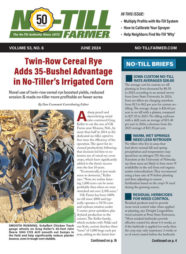- Grassed waterways
- Cover crops
- Fields with <2% slope
- Soil incorporation
- Water retention systems
No-Till Farmer
Get full access NOW to the most comprehensive, powerful and easy-to-use online resource for no-tillage practices. Just one good idea will pay for your subscription hundreds of times over.






Post a comment
Report Abusive Comment